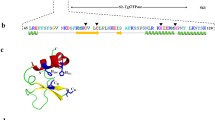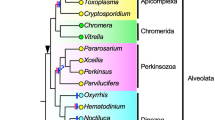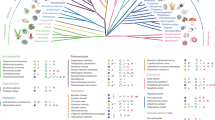Abstract
Goldfish Tgf2 transposon of Hobo/Activator/Tam3 (hAT) family can mediate gene insertion in a variety of aquacultural fish species by transposition; however, the protein structure of Tgf2 transposase (TPase) is still poorly understood. To express the goldfish Tgf2 TPase in Escherichia coli, the 2061-bp coding region was cloned into pET-28a(+) expression vector containing an N-terminal (His)6-tag. The pET-28a(+)-Tgf2 TPase expression cassette was transformed into Rosetta 1 (DE3) E. coli lines. A high yield of soluble proteins with molecular weight of ~80 kDa was obtained by optimized cultures including low-temperature (22 °C) incubation and early log phase (OD600 = 0.3–0.4) induction. Mass spectrometry analysis following trypsin digestion of the recombinant proteins confirmed a Tgf2 TPase component in the eluate of Ni2+-affinity chromatography. When co-injected into 1–2 cell embryos with a donor plasmid harboring a Tgf2 cis-element, the prokaryotic expressed Tgf2 TPase can mediate high rates (45 %) of transposition in blunt snout bream (Megalobrama amblycephala). Transposition was proved by the presence of 8-bp random direct repeats at the target sites, which is the signature of hAT family transposons. Production of the Tgf2 Tpase protein in a soluble and active form not only allows further investigation of its structure, but provides an alternative tool for fish transgenesis and insertional mutagenesis.





Similar content being viewed by others
References
Huang, C. R., Burns, K. H., & Boeke, J. D. (2012). Active transposition in genomes. Annual Review of Genetics, 46, 651–675.
de Boer, J. G., Yazawa, R., Davidson, W. S., & Koop, B. F. (2007). Bursts and horizontal evolution of DNA transposons in the speciation of pseudotetraploid salmonids. BMC Genomics, 8, 422.
Feschotte, C., & Pritham, E. J. (2007). DNA transposons and the evolution of eukaryotic genomes. Annual Review of Genetics, 41, 331–368.
Benjak, A., Forneck, A., & Casacuberta, J. M. (2008). Genome-wide analysis of the “cut-and-paste” transposons of grapevine. PLoS ONE, 3, e3107.
Zhang, J., & Peterson, T. (2004). Transposition of reversed Ac element ends generates chromosome rearrangements in maize. Genetics, 167, 1929–1937.
Kawakami, K., Imanaka, K., Itoh, M., & Taira, M. (2004). Excision of the Tol2 transposable element of the medaka fish Oryzias latipes in Xenopus laevis and Xenopus tropicalis. Gene, 338, 93–98.
Kawakami, K., & Shima, A. (1999). Identification of the Tol2 transposase of the medaka fish Oryzias latipes that catalyzes excision of a nonautonomous Tol2 element in zebrafish Danio rerio. Gene, 240, 239–244.
Mates, L., Chuah, M. K., Belay, E., Jerchow, B., Manoj, N., Acosta-Sanchez, A., et al. (2009). Molecular evolution of a novel hyperactive Sleeping Beauty transposase enables robust stable gene transfer in vertebrates. Nature Genetics, 41, 753–761.
Kawakami, K. (2007). Tol2: a versatile gene transfer vector in vertebrates. Genome Biology, 8(Suppl 1), S7.
Nagayoshi, S., Hayashi, E., Abe, G., Osato, N., Asakawa, K., Urasaki, A., et al. (2008). Insertional mutagenesis by the Tol2 transposon-mediated enhancer trap approach generated mutations in two developmental genes: tcf7 and synembryn-like. Development, 135, 159–169.
He, X., Li, J., Long, Y., Song, G., Zhou, P., Liu, Q., et al. (2013). Gene transfer and mutagenesis mediated by Sleeping Beauty transposon in Nile tilapia (Oreochromis niloticus). Transgenic Research, 22, 913–924.
Furushima, K., Jang, C. W., Chen, D. W., Xiao, N., Overbeek, P. A., & Behringer, R. R. (2012). Insertional mutagenesis by a hybrid piggyBac and sleeping beauty transposon in the rat. Genetics, 192, 1235–1248.
Geurts, A. M., Wilber, A., Carlson, C. M., Lobitz, P. D., Clark, K. J., Hackett, P. B., et al. (2006). Conditional gene expression in the mouse using a Sleeping Beauty gene-trap transposon. BMC Biotechnology, 6, 30.
Froschauer, A., Sprott, D., Gerwien, F., Henker, Y., Rudolph, F., Pfennig, F., et al. (2012). Effective generation of transgenic reporter and gene trap lines of the medaka (Oryzias latipes) using the Ac/Ds transposon system. Transgenic Research, 21, 149–162.
Clark, K. J., Geurts, A. M., Bell, J. B., & Hackett, P. B. (2004). Transposon vectors for gene-trap insertional mutagenesis in vertebrates. Genesis, 39, 225–233.
Kawakami, K., Takeda, H., Kawakami, N., Kobayashi, M., Matsuda, N., & Mishina, M. (2004). A transposon-mediated gene trap approach identifies developmentally regulated genes in zebrafish. Developmental Cell, 7, 133–144.
Cheng, L. D., Jiang, X. Y., Tian, Y. M., Chen, J., & Zou, S. M. (2014). The goldfish hAT-family transposon Tgf2 is capable of autonomous excision in zebrafish embryos. Gene, 536, 74–78.
Clark, K. J., Carlson, D. F., Leaver, M. J., Foster, L. K., & Fahrenkrug, S. C. (2009). Passport, a native Tc1 transposon from flatfish, is functionally active in vertebrate cells. Nucleic Acids Research, 37, 1239–1247.
Jiang, X. Y., Du, X. D., Tian, Y. M., Shen, R. J., Sun, C. F., & Zou, S. M. (2012). Goldfish transposase Tgf2 presumably from recent horizontal transfer is active. The FASEB Journal, 26, 2743–2752.
Zou, S. M., Du, X. D., Yuan, J., & Jiang, X. Y. (2010). Cloning of goldfish hAT transposon Tgf2 and its structure. Hereditas, 32, 1263–1268.
Zhang, L., Sun, C., Ye, X., Zou, S., Lu, M., Liu, Z., et al. (2014). Characterization of four heat-shock protein genes from Nile tilapia (Oreochromis niloticus) and demonstration of the inducible transcriptional activity of Hsp70 promoter. Fish Physiology and Biochemistry, 40, 221–233.
Guo, X. M., Huang, C. X., Shen, R. J., Jiang, X. Y., Chen, J., & Zou, S. M. (2013). Insertion efficiency of Tgf2 transposon in the genome of Megalobrama amblycephala. Hereditas, 35, 999–1006.
Yan, X., Zhong, S. S., Peng, X., Zou, S. M., & Sun, X. W. (2014). Study on transgenic efficiency of Fst1 gene element mediated by Tgf2 transposon in common carp. Journal of Shanghai Ocean University, 23, 1–7.
Tafalla, C., Estepa, A., & Coll, J. M. (2006). Fish transposons and their potential use in aquaculture. Journal of Biotechnology, 123, 397–412.
Shibano, T., Takeda, M., Suetake, I., Kawakami, K., Asashima, M., Tajima, S., et al. (2007). Recombinant Tol2 transposase with activity in Xenopus embryos. FEBS Letters, 581, 4333–4336.
Nesmelova, I. V., & Hackett, P. B. (2010). DDE transposases: Structural similarity and diversity. Advanced Drug Delivery Reviews, 62, 1187–1195.
Zhang, L., Dawson, A., & Finnegan, D. J. (2001). DNA-binding activity and subunit interaction of the mariner transposase. Nucleic Acids Research, 29, 3566–3575.
Zou, S. M., Li, S., Cai, W., Zhao, J., & Yang, H. (2004). Establishment of fertile tetraploid population of blunt snout bream (Megalobrama amblycephala). Aquaculture, 238, 155–164.
Sambrook, J., Fritsch, E. F., & Maniatis, T. (1989). Molecular cloning: A laboratory manual (2nd ed.). NewYork: Cold Spring Harbor, USA.
Dumon-Seignovert, L., Cariot, G., & Vuillard, L. (2004). The toxicity of recombinant proteins in Escherichia coli: a comparison of overexpression in BL21(DE3), C41(DE3), and C43(DE3). Protein Expression and Purification, 37, 203–206.
Sahdev, S., Khattar, S. K., & Saini, K. S. (2008). Production of active eukaryotic proteins through bacterial expression systems: a review of the existing biotechnology strategies. Molecular and Cellular Biochemistry, 307, 249–264.
San-Miguel, T., Perez-Bermudez, P., & Gavidia, I. (2013). Production of soluble eukaryotic recombinant proteins in is favoured in early log-phase cultures induced at low temperature. SpringerPlus, 2, 89.
Qing, G., Ma, L. C., Khorchid, A., Swapna, G. V., Mal, T. K., Takayama, M. M., et al. (2004). Cold-shock induced high-yield protein production in Escherichia coli. Nature Biotechnology, 22, 877–882.
Lamb-Palmer, N. D., Singh, M., Dalton, J. P., & Singh, J. (2013). Prokaryotic expression and purification of soluble maize Ac transposase. Molecular Biotechnology, 54, 685–691.
Trubitsyna, M., Morris, E. R., Finnegan, D. J., & Richardson, J. M. (2014). Biochemical characterization and comparison of two closely related active mariner transposases. Biochemistry, 53, 682–689.
Zou, S. M., & Jiang, X. Y. (2011). Transposon-mediated transgenesis and gene trap strategies in fish. In X. Sun & P. Xu (Eds.), Progress in aquaculture genome technology and research (pp. 188–202). Beijing, China: Ocean Press.
Acknowledgments
This work was supported by Grants from the National High Technology Research and Development Program of China (863 Program) (2011AA100403) and the National Science Foundation of China (Nos. 31201760 and 31272633).
Author information
Authors and Affiliations
Corresponding authors
Additional information
Hai-Li Xu and Xiao-Dan Shen have contributed equally to this work.
Rights and permissions
About this article
Cite this article
Xu, HL., Shen, XD., Hou, F. et al. Prokaryotic Expression and Purification of Soluble Goldfish Tgf2 Transposase with Transposition Activity. Mol Biotechnol 57, 94–100 (2015). https://doi.org/10.1007/s12033-014-9805-6
Published:
Issue Date:
DOI: https://doi.org/10.1007/s12033-014-9805-6




